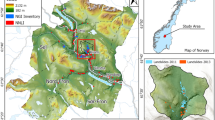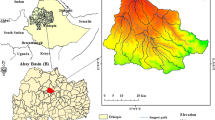Abstract
Using the Murrumbidgee Irrigation Area, Australia as a case study, we present an integrated approach for identifying seepage hotspots and predicting seepage losses from open channel. The approach is particularly important to facilitate investments for improving irrigation conveyance efficiencies, thus enabling sustainable agricultural water use. A qualitative assessment is used for capturing seepage hotspots with electromagnetic inductance (EM31) imaging techniques, followed by actual seepage measurements. Based on data from major irrigation systems in the southern Murrumbidgee Irrigation Area, a case is made for cost-effective methodology to locate seepage hotspots and quantify seepage losses in channels. In particular, a predictive model was developed based on EM31 survey and direct measured channel seepage data. The main input data for the model were EM values, soil types, water depth in channels, wetted perimeter of channels and whether water is flowing in channels. The output from the model was a seepage loss value in channels. The three different modelling techniques considered were the Generalised Linear Mixed (GLM) model, Random Forest (RF) model and Generalized Boosted Regression Model (GBM), and a best performing model for seepage prediction was identified. The RF model was found to the most reliable, explaining 60% of the variability in the data and with the least mean absolute error. The study indicated that the RF model can be used to locate seepage hotspots in channels and determine the magnitude of seepage losses.


(Source MIL 2010)






Similar content being viewed by others
References
Akbar S (2005) Measurement of losses from on-farm channels and drains. https://ret.sunrice.com.au/Australian%20Rice%20Library/Akbar%20CRC1.PDF. Accessed 22 March 2018
Akbar S, Abbas A, Hanjra MA, Khan S (2013) Structured analysis of seepage losses in irrigation supply channels for cost-effective investments: case studies from the southern Murray-Darling Basin of Australia. Irrig Sci 31(1):11–25
Ayaru L, Ypsilantis PP, Nanapragasam A, Choi RCH, Thillanathan A, Min-Ho L, Montana G (2014) Prediction of outcome in acute lower gastrointestinal bleeding using gradient boosting. PLoS One 10:7
Breiman L (1996) Bagging predictors. Machine Learn 24(2):123–140
Breiman L (2001) Random Forests. Mach Learn 45(1):5–32
Diggle PJ (1990) Time Series: a biostatistical introduction. Clarendon Press, Oxford
Dodd S, Berk M, Kelin K, Zhang Q, Eriksson E, Deberdt W, Nelson JC (2014) Application of the gradient boosted method in randomised clinical trials: participant variables that contribute to depression treatment efficacy of duloxetine, SSRIs or placebo. J Affect Disord 168:284–293
Eman A, Akram A, Ghorbani MA, Farzin S (2013) Estimation of channels seepage using Seep/w and evolutionary polynomial regression (EPR) modelling (case study: Qazvin and Isfahan Channels) 2013. Sci Publ J Civil Eng Urban 3(4):211–215
Evans JS, Murphy MA, Holden ZA, Cushman SA (2011) Modeling species distribution and change using random forest. In: Predictive species and habitat modelling in landscape ecology. Springer, New York, pp 139–159
Freund Y, Schapire R (1997) A decision-theoretic generalization of on-line learning and an application to boosting. J Comput Syst Sci 55:119–139
Friedman J (2001) Greedy boosting approximation: a gradient boosting machine. Ann Stat 29:1189–1232
Friedman J, Hastie T, Tibshirani R (2000) Additive logistic regression: a statistical view of boosting. Ann Stat 28:337–407
Gröm** U (2009) Variable importance assessment in regression: linear regression versus random forest. Am Stat 63(4):308–319
Hastie T, Tibshirani R, Friedman J (2001) The elements of statistical learning. Data mining, inference, and prediction. Springer, New York
Khan S, Akbar S, Rana T, Abbas A, Robinson D, Dassanayake D, Hirsi I, Blackwell J, Xevi E, Carmichael A (2005) Hydrologic economic ranking of water savings options. Murrumbidgee valley water efficiency feasibility project. Consultancy report to Pratt Water Group. CSIRO Land and Water, Griffith, NSW, Australia. http://www.napswq.gov.au/publications/books/prattwater/working-papers/hydrologic.html
Khan S, Rana T, Dassanayake D, Abbas A, Blackwell J, Akbar S, Gabriel HF (2009) Spatially distributed assessment of channel seepage using geophysics and artificial intelligence. ANN Irrig Drain 58(3):307–320
Kinzli KD, Martinez M, Oad R, Prior A, Gensler D (2010) Using an ADCP to determine canal seepage loss in an irrigation district. Agric Water Manag 97:801–810
Liaw A, Wiener M (2002) Classification and regression by Random Forest. R News 2:18–22
Littell RC, Milliken GA, Stroup WW, Wolfinger RD (2006) SAS system for mixed models, 2nd edn. SAS Institute Inc, Cary
Niswonger RG, Prudic DE, Fogg GE, Stonestrom DA, Buckland EM (2008) Method for estimating spatially variable seepage loss and hydraulic conductivity in intermittent and ephemeral streams. Water Resour Res 44:W05418
Pinheiro JC, Bates DM (2000) Mixed-effects models in S and S-Plus. Springer, New York
Prasad AM, Iverson LR, Liaw A (2006) Newer classification and regression tree techniques: bagging and random forests for ecological prediction. Ecosystems 9(2):181–199
R Development Core Team (2015) R: A language and environment for statistical computing. R Foundation for Statistical Computing, Vienna, Austria. http://www.R-project.org
Ripley BD (1996) Pattern recognition and neural networks. Cambridge University Press, Cambridge (ISBN 0-521-46086-7)
Tukey JW (1980) We need both exploratory and confirmatory. Am Stat 34(1):23–25
Vincenzi S, Zucchetta M, Franzoi P, Pellizzato M, Pranovi F, De Leo GA, Torricelli P (2011) Application of a Random Forest algorithm to predict spatial distribution of the potential yield of Ruditapes philippinarum in the Venice lagoon, Italy. Ecol Model 222(8):1471–1478
Wang L, Liu ZP, Zhang XS, Chen L (2012) Prediction of hot spots in protein interfaces using a random forest model with hybrid features. Protein Eng Des Sel 25(3):119–126
Watt J, Khan S (2007) The use of geophysics to model channel seepage. In: Proceedings: MODSIM07—Land, water and environmental management: integrated systems for sustainability. https://www.mssanz.org.au/MODSIM07/papers/23_s31/TheUseOfGeograhysics_s31_Jacqueline_.pdf
Wheeler S, Garrick D, Loch A, Bjornlund H (2013) Evaluating water market products to acquire water for the environment in Australia. Land Use Policy 30(1):427–436
Zhang Y, Haghani A (2015) A gradient boosting method to improve travel time prediction. Transp Res Part C Emerg Technol 58:308–324
Zuur AF, Ieno EN, Walker N, Saveliev AA, Smith GM (2009) Mixed effects models and extensions in ecology with R. Springer, New York
Acknowledgements
The author acknowledges technical contributions from a number of his colleagues including Professor Shahbaz Khan, Dr. Akhtar Abbas, and Dr. Mohsin Hafeez. Data from the NSW Department of Primary Industries and Murrumbidgee Irrigation Limited and Coleambally Irrigation Co-operative Limited are acknowledged.
Author information
Authors and Affiliations
Corresponding author
Additional information
Communicated by G. Markley.
Rights and permissions
About this article
Cite this article
Akbar, S., Kathuria, A. & Maheshwari, B. Combining imaging techniques with nonparametric modelling to predict seepage hotspots in irrigation channels. Irrig Sci 37, 11–23 (2019). https://doi.org/10.1007/s00271-018-0596-6
Received:
Accepted:
Published:
Issue Date:
DOI: https://doi.org/10.1007/s00271-018-0596-6




